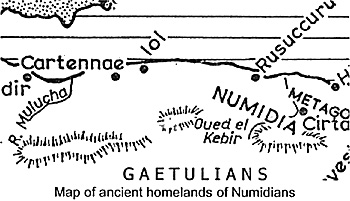One of the most enduring pictures of the ancient world is the swift moving Numidian horsemen. There are literary characterizations of him trotting out against the powers of Carthage or Rome on a swift horse, armed with nothing but a small shield, and a fistful ofjavelins.
From the Punic Wars to the campaigns of Trajan, the destiny of these irrepressible riders seems closely linked with Rome, and the association was often turbulent. Although they were enemies as well as allies for a long time, were they as good as legend makes them?
The primary sources used here are : Livy, "The History of Rome", Caesar, "The Civil War", Sallust, "The Jugurthine War" and Polybios "Histories."
The People
 It was believed in ancient times that Afiica was originally populated by Gaetulians and Libyans, both were nomadic people. The demigod Hercules died in Spain and his polyglot eastern anny was left to settle the land, with some migrating to Africa. Persians went to the West and inter-married with the Gaetulians and became the Numidians. The Medes settled and were known as Mauri latter Moors. Sallust's version of African history must be considered with reservations. These stories more likely recall Aryan invasions from Spain.
It was believed in ancient times that Afiica was originally populated by Gaetulians and Libyans, both were nomadic people. The demigod Hercules died in Spain and his polyglot eastern anny was left to settle the land, with some migrating to Africa. Persians went to the West and inter-married with the Gaetulians and became the Numidians. The Medes settled and were known as Mauri latter Moors. Sallust's version of African history must be considered with reservations. These stories more likely recall Aryan invasions from Spain.
The Numidians and Moors belonged to the race from which the Berbers are descended. The translated meaning of 'Numidian' is 'Nomad' and indeed the people were semi-nomadic until the reign of Masinissa of the Massyli tribe. He was initially on the side of Carthage, but went over to the Romans with decisive effect in 206 B.C.E. Given additional land at the expense of Carthage, the king retained the support of Rome for 50 years until his death in 148 B.C.E. Masinissa began to turn his people from rovers to peasant farmers and those who fled the destruction of Carthage and settled the land helped this process.
The kingdom was divided into three by Rome and remained so until an illegitimate prince named Jugurtha forcibly reunited the land in 118 B.C.E., but the Romans won it back by 105 B.C.E. Rome maintained client Kings and reduced the size of the country and things remained so until Juba I attempted to rebuild the state 49 - 46 B.C.E. After his defeat, Numidia became part of the Roman Empire. Unlike most countries, Numidians were recruited into the army in their own attire and using their own weapon. The Numidians are shown thus on Trajan's column, which indicates the value Rome placed upon them as light cavalry.
Numida stretched for 700 miles along the African coast occupying about the position of modern day Algeria with the Western part of Tunisia. The coastal plains were fertile, the interior less so turning to rolling scrub and tree covered hills and as one goes further south the bleak rugged Atlas Mountains and the barren desert are encountered. Such land encouraged the development of the horse for transportation.
More Numidians
-
The People
Numidians at War
Numidian Cavalry
Numidian Infantry
Numidian Elephants
Wargaming with a Numidian Army
Back to Strategikon Vol. 1 No. 2 Table of Contents
Back to Strategikon List of Issues
Back to MagWeb Master Magazine List
© Copyright 2001 by NMPI
This article appears in MagWeb (Magazine Web) on the Internet World Wide Web. Other military history articles and gaming articles are available at http://www.magweb.com